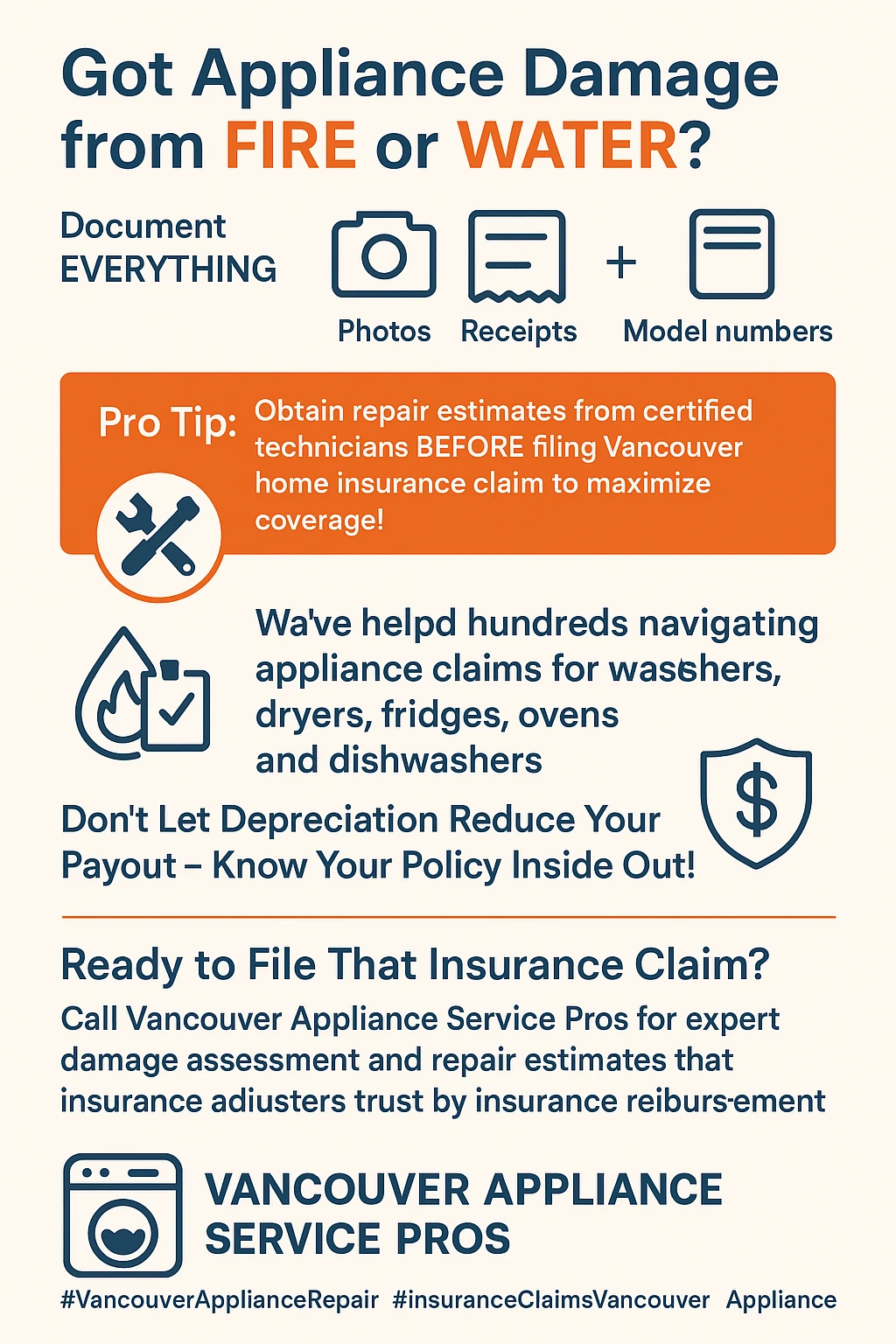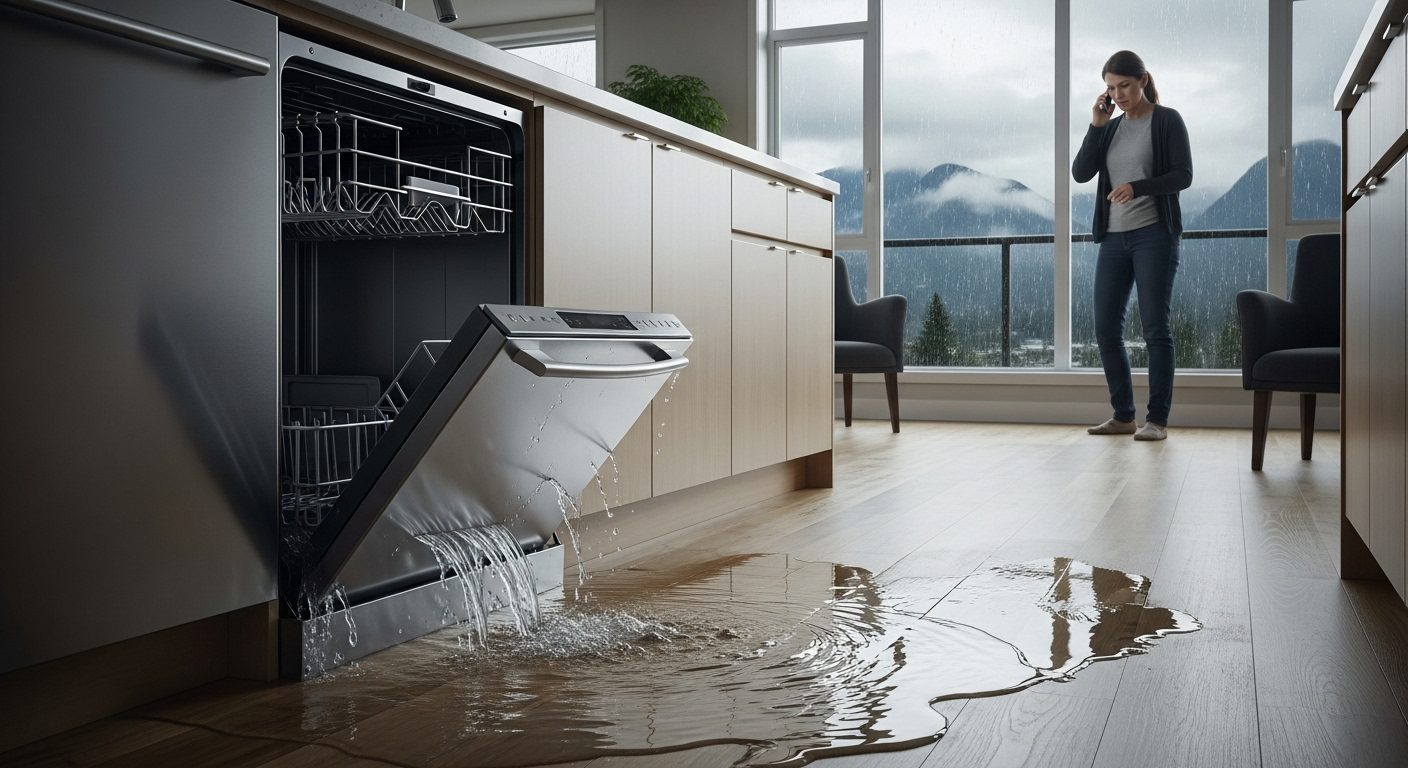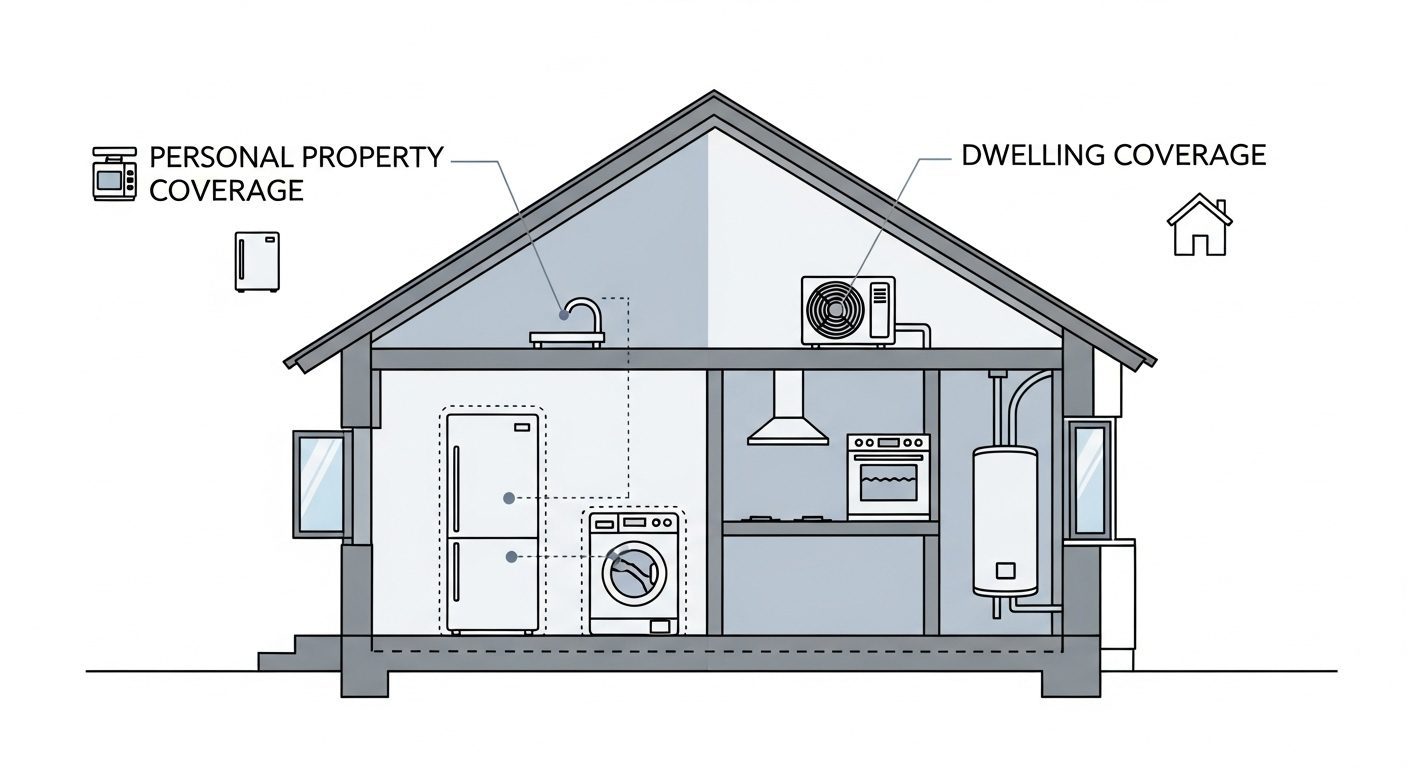Vancouver Appliance Insurance Claims: How to Document Damage, File Successfully, and Get Maximum Coverage for Repairs
Dealing with a broken appliance and wondering if your Vancouver home insurance will actually cover the damage? You’re not alone – many homeowners discover too late that improper documentation or missed filing deadlines can turn a covered claim into an expensive out-of-pocket repair bill.
Picture this: your three-year-old dishwasher suddenly floods your kitchen during Vancouver’s notorious winter storms, causing water damage to your hardwood floors and cabinets. You think you’re covered, but six months later you’re still fighting with your insurance company over depreciation calculations and coverage limits. Unfortunately, this scenario plays out in Vancouver homes more often than you’d think, especially with our city’s unique coastal climate creating appliance challenges that standard insurance policies don’t always address clearly.
The reality is that successful appliance insurance claims require much more than just calling your agent and hoping for the best. From understanding the difference between personal property and dwelling coverage to documenting Vancouver’s specific climate-related damage patterns, homeowners need a strategic approach to maximize their coverage. What makes Vancouver particularly tricky is our mix of older heritage homes, modern strata regulations, and coastal conditions that create unique damage scenarios insurance adjusters don’t see in other markets.
Whether you’re dealing with salt air corrosion on your appliances, electrical surge damage from BC Hydro fluctuations, or water damage from Vancouver’s aging infrastructure, understanding the claims process can mean the difference between full replacement coverage and a disappointing settlement that leaves you thousands of dollars short. The key is knowing what documentation to gather, when to file, and how to work effectively with adjusters who may not understand Vancouver’s specific housing and climate challenges.
Key Outtakes:
- Proper documentation within 24 hours of appliance damage significantly increases claim approval rates and settlement amounts
- Vancouver’s coastal climate creates unique appliance damage patterns requiring specialized documentation for salt air corrosion and humidity effects
- Home insurance covers appliances through personal property coverage (portable items) or dwelling coverage (built-in systems), with different limits and deductibles
- Strata and condominium appliance claims require additional documentation and coordination that’s unique to Vancouver’s high-density housing market
- Understanding depreciation calculations and replacement cost coverage can help homeowners negotiate settlements that reflect Vancouver’s premium appliance market pricing

Understanding Vancouver Home Insurance Coverage for Appliances

Before you can successfully file an appliance insurance claim in Vancouver, you need to understand exactly what your home insurance policy covers and how appliances are classified. This isn’t as straightforward as most homeowners assume, especially in Vancouver where our unique housing mix of heritage homes, modern condos, and strata regulations creates coverage complications that don’t exist in other markets.
Most Vancouver home insurance policies classify appliances into two distinct categories that determine your coverage limits and deductibles. Personal property coverage typically applies to portable appliances like refrigerators, washing machines, dryers, and standalone freezers. These items are usually covered for 50-70% of your dwelling coverage amount, which means if you have a $500,000 home, your personal property coverage might cap out at $250,000-$350,000 total. However, this coverage is shared among all your belongings, so appliances compete with furniture, electronics, and clothing for the same coverage pool.
Dwelling coverage, on the other hand, applies to built-in appliances that are considered part of your home’s structure. This includes systems like HVAC units, water heaters, built-in dishwashers, and range hoods that are permanently installed. The good news is that dwelling coverage typically offers higher limits and sometimes lower deductibles than personal property coverage. The challenging part is that insurance companies don’t always agree on which appliances fall into which category, especially in Vancouver’s older homes where appliances might be semi-built-in or modified to fit unique spaces.
Vancouver homeowners also need to understand covered perils – the specific types of damage that trigger insurance coverage. The most common covered perils for appliance damage include electrical surges from power fluctuations during our frequent storms, fire damage that affects appliances beyond repair, sudden and accidental water damage from burst pipes or appliance malfunctions, and theft of portable appliances during break-ins. What’s crucial to understand is that normal wear and tear, gradual leaks, or maintenance issues are specifically excluded from coverage, regardless of how expensive the resulting damage might be.
One coverage option that’s becoming increasingly important for Vancouver homeowners is Home Systems and Appliance Breakdown (HSAB) coverage. This optional coverage provides up to $50,000 in protection with a $500 deductible per occurrence, specifically designed to cover mechanical, electrical, or pressurized system breakdowns that wouldn’t otherwise be covered under standard home insurance. For Vancouver’s strata buildings, HSAB coverage is often essential because shared utility systems can create individual unit liability that standard policies don’t address adequately.
The challenge with Vancouver’s coastal climate is that it creates unique damage patterns that don’t always fit neatly into standard insurance categories. Salt air can cause gradual corrosion that might be classified as wear and tear by some adjusters but could be considered environmental damage by others. High humidity levels can cause electrical component failures that look like manufacturing defects but are actually climate-related damage. Understanding these nuances helps you document and present your claim in a way that maximizes your chances of coverage approval.
Proper Documentation Techniques for Vancouver Appliance Damage

The success of your appliance insurance claim often depends entirely on the quality and completeness of your initial documentation. Vancouver homeowners face unique challenges because our coastal climate and diverse housing stock create damage patterns that adjusters from other regions might not immediately understand or appreciate. The key is creating a comprehensive record that tells the complete story of what happened, why it happened, and what the full extent of the damage includes.
Immediate documentation should begin the moment you discover appliance damage, ideally within the first 24 hours when details are fresh and evidence is most clear. Start with taking detailed photos and videos from multiple angles, showing not just the damaged appliance but also the surrounding area, any water damage, electrical issues, or secondary effects. For each damaged appliance, photograph the make, model, and serial number labels – these are crucial for determining replacement costs and warranty status. Don’t forget to document any visible signs of the damage cause, such as burn marks from electrical surges, water stains from leaks, or impact damage from falling objects.
Vancouver’s marine climate requires special attention to documenting both immediate and potential long-term damage effects. Salt air corrosion doesn’t always appear immediately but can significantly impact appliance performance and longevity. When photographing exterior units like heat pumps or air conditioning systems, look for signs of salt buildup, unusual rust patterns, or corrosion on electrical connections that might not be visible to adjusters unfamiliar with coastal conditions. Humidity-related electrical component failures are another common issue in Vancouver homes that require careful documentation of moisture levels, ventilation problems, or signs of condensation that might have contributed to the breakdown.
Professional assessment documentation becomes crucial when dealing with complex appliance failures or expensive equipment. Obtain certified technician reports that detail the breakdown causes, especially when the damage might be related to installation issues, electrical problems, or environmental factors specific to Vancouver. Keep all repair estimates and diagnostic reports, even if you don’t plan to use those particular services. These professional opinions carry significant weight with insurance adjusters and can help establish that the damage was sudden and accidental rather than the result of normal wear and tear.
One often-overlooked aspect of documentation is recording any temporary measures you take to prevent further damage. If you shut off water mains, disconnect electrical connections, or move other appliances to safety, photograph these actions and keep detailed notes about when and why you took each step. Insurance companies appreciate proactive damage mitigation, and this documentation can actually strengthen your claim by showing that you acted reasonably to minimize losses.
For Vancouver strata properties, documentation becomes more complex because you need to establish ownership responsibility and compliance with strata bylaws. Photograph any shared utility connections, document which appliances are your responsibility versus the strata corporation’s, and keep records of any strata council communications about the damage. This documentation helps prevent disputes between your insurance and the strata insurance about coverage responsibility.
Vancouver-Specific Filing Process and Requirements

Filing an appliance insurance claim in Vancouver involves navigating both standard insurance procedures and city-specific requirements that can significantly impact your claim’s success. The process begins with immediate notification to your insurance agent, ideally within hours of discovering the damage, with your policy number ready and a clear description of what happened. Vancouver homeowners should be particularly detailed about environmental factors that might have contributed to the damage, such as recent storms, power fluct




